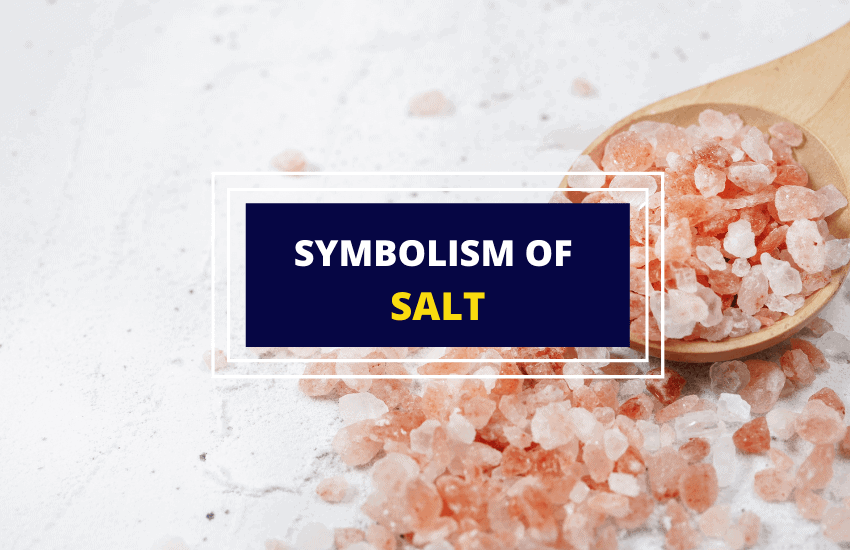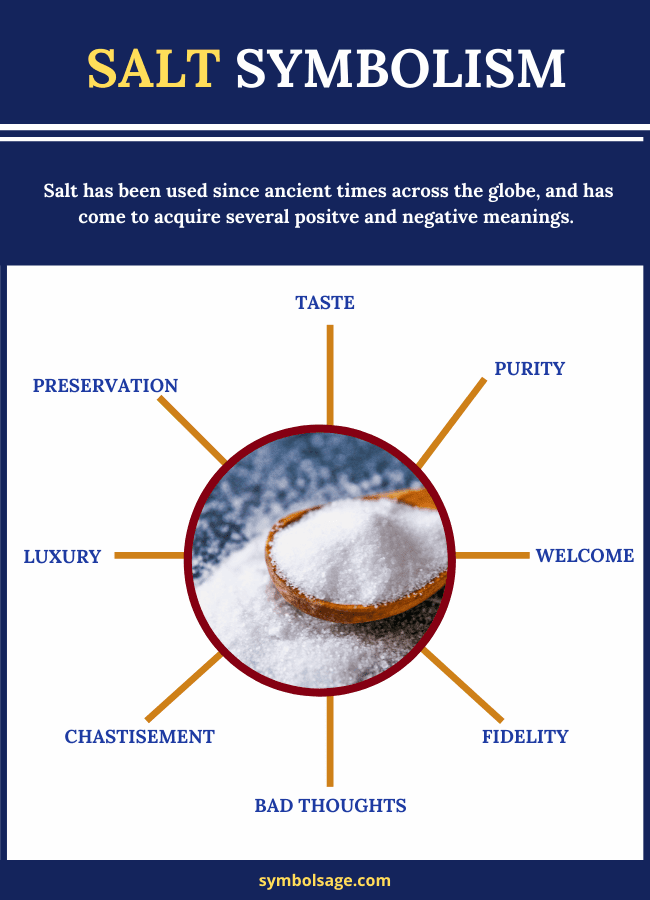
Table of Contents
Salt is one of those things we know and experience from a young age, so much so that we wouldn’t think much of it. Intriguingly, there is a lot of history and symbolism attached to salt and uses of salt that most people don’t know about. Here is what you need to know about salt.
What Is Salt

Scientifically known as Sodium Chloride, salt is a product of neutralization (reaction between an acid and a base). Generally speaking, salt is obtained by processing salt mines, or by evaporating either seawater or spring water.
The earliest documented traces of the usage of salt date back to 6000 BC where salt was extracted from evaporated water by civilizations such as Romania, China, Egyptians, Hebrews, Indians, Greeks, Hittites, and Byzantines. History shows that salt is so much a part of civilizations that it has even caused nations to go to war.
Salt comes in different textures and a variety of colors ranging from white to pink, purple, gray, and black.
Salt Symbolism And Meaning
Because of its characteristic qualities and usage in pre-medieval life and customs, salt has for centuries been a symbol of taste, purity, preservation, fidelity, luxury, and welcome. Salt, however, is also associated with bad connotations namely chastisement, contamination, bad thoughts, and sometimes death.
- Taste – The taste symbolic meaning of salt is derived from its use as a seasoning agent in food by various civilizations across centuries.
- Purity – Salt became a symbol of purity because it was used by an ancient civilization to ward off evil spirits, mummify bodies, and treat wounds.
- Preservation – This symbolic meaning stems from the usage of salt as a food preservative and for mummification of the dead.
- Fidelity – Salt gained its fidelity symbolism from religious folklore whereby it was used to create binding covenants usually together with other sacrifices.
- Luxury – In ancient days, salt was a commodity only affordable to royalty and a select rich, hence its luxurious connotation.
- Welcome – The welcoming attribute of salt is a derivative of the Slavic traditional welcoming ceremony whereby bread and salt were offered to guests.
- Chastisement – Salt became a symbol of chastisement after Lot’s wife was turned into a pillar of salt for looking back at Sodom (the book of Genesis in the Bible).
- Bad Thoughts – This symbolism is derived from salty water, whereby water is a representative of pure emotions whilst salt is a representative of negative emotions.
- Contamination and Death – Salt is associated with contamination and death because of its corrosive ability on substances, and its ability to dry plants and ruin drinking water.

Salt in Dreams
Dreams have for centuries been seen as a system of communication between divinity or the universe and humankind. Salt connotes varying meanings in dreams as is shown below.
- When salt appears in a dream as an object held in hand or appears in the dream in a form that is crystallized, then it is seen to mean that the dreamer will soon experience joy and happiness or gain profit.
- When salt in a dream is spilled, the dreamer is being warned of or alerted to problems in the home.
- If a dreamer sees salt dissolve in the rain while in a serene environment, then in this case it is an indication of reconciliation.
- Surprisingly salt added to food in a dream servers as a caution of looming illness.
Salt in Language
Salt, again owing to its characteristics and uses, has been incorporated into the English language mainly in idioms. Examples of these are:
- Add salt to the wound – Used to mean causing additional pain or making bad situations worse. This idiom came about because of the excruciating pain caused by literally adding salt to an open wound.
- Worth your salt – Used to mean that one serves their anticipated purpose as they should. This idiom is said to originate from slavery whereby a slave’s worth was measured in comparison to salt.
- Salt of the earth – Used to mean good and influential. This idiom is associated with the Biblical ‘Sermon on the Mountain’ found in Matthew 5:13.
- To take with a grain of salt – Used to encourage one not to believe everything they are told, especially when it seems exaggerated or not representing the real truth.
- Salt to my coffee – This is an informal modern-day idiom used to mean that however important someone or something may be perceived to be, they/it can be pretty useless or damaging to another person. This is because salt, as much as it is an important flavoring agent, shouldn’t be added to coffee and has no use to coffee.
Folklore Concerning Salt
For as long as it has been in active use, salt has held an undeniable significance in religions and cultures across the globe. The collection of stories and myths concerning salt is vast enough to have an independent book written. We will, however, briefly mention a few in here.
- In pre-medieval Greek, salt was consecrated in rituals. For instance, salt was sprinkled on all sacrificial animals by the Vestal Virgins alongside flour.
- According to Chinese folklore, salt was discovered at a point where a phoenix rose from the ground. The story tells of a peasant who on witnessing the occurrence, knew that the phoenix’s point of rising had to hold treasure. He dug on for the said treasure and on finding none, settled for the white soil which he gifted to the sitting emperor. The emperor had the peasant killed for gifting him mere soil but later discovered the real value of it after some of the ‘soil’ accidentally fell into his soup. Feeling great shame, the Emperor then gave the late peasant’s family control of the salt-yielding lands.
- According to Norse mythology, the gods were born of an ice-block, salty in nature, a process that took around four days to be completed. They were later brought to life as Adumbla, a cow, licked the salt and released them.
- In Mesopotamian religion, the arch of heaven and earth was created from the dead body of Tiamat, the ocean’s salty goddess. The story of her death also endorses her as the symbol of chaos.
- The Hittites were known to venerate Hatta, the god of salt, by putting up a statue of him. The Hittites also used salt to create curses. For instance, salt is used to create a curse for possible treason as part of every soldier’s first oath.
- According to Aztec religion, Huixtocihuatl a fertility goddess was in charge of saltwater and over salt itself. This happened after she had been banished by her brothers to the salt beds for angering them. It is during her time in the salt beds that she discovered salt and introduced it to the rest of the population. Consequently, Huixtocihuatl was honored by salt makers in a ten-day ceremony that involved the sacrifice of a human embodiment of her also known as Huixtocihuatl’s Ixiptla.
- In a Shinto rite, a Japan originating religion, salt is used to purify the match ring before a fight ensues, primarily to dispel malevolent spirits. The Shintoists also place bowls of salt in establishments to dispel evil spirits and attract customers
- Hindu house warming and wedding ceremonies use salt.
- In Jainism, offering salt to deities is a show of devotion
- In Buddhism, salt was used to dispel evil spirits and as such a pinch of it cast over the left shoulder after leaving a funeral was believed to deter evil spirits from getting into the house
- Greeks used salt to celebrate the new moon whereby it was thrown into the fire so that it could crackle.
- Ancient Romans, Greeks, and Egyptians were also known to offer salt and water as a way to invoke gods. This, to some believers, is the origin of the Holy water used by Christians.
Salt Sybmolism in Chrsitianity
Christianity makes reference to salt symbolism more than any other. The Bible pays tribute to the symbolism of salt on occasion starting from the Old Testament through to the New Testament. This fascination with salt is attributed to Jews who lived next to the dead sea, a salt lake that was the main source of salt to all neighboring communities. We will mention a few.
The Old testament refers to the use of salt to consecrate land that had been used for battle to the Lord. This ritual is referred to as “salting the earth.”
The book of Ezekiel highlights a customary practice that involved rubbing salt onto newborns for its antiseptic qualities as well as a way of proclaiming blessings and abundance into their lives.
The Book of 2 Kings highlights the use of salt for purification by alluding that water is made pure by adding some salt to it. In the book of Ezekiel, God instructed the Israelites to use salt to season their grain offerings.
However, the most remarkable Old Testament reference to salt is the Genesis 19 story of how Lot’s wife was turned into a pillar of salt because she looked back at Sodom and Gomorrah as these cities burned.
In the New Testament, Jesus tells his disciple, “You are the salt of the earth” ( Matthew 5:13). In another verse, Colossians 4: 6, the apostle Paul tells Christians, “Let your conversation be always full of grace, seasoned with salt”.
Uses of Salt
As we have established, salt has held an important place in history and cultures across the world. Below are the commonly known uses of salt.
- Salt was used in funeral ceremonies by Egyptians, Indians, Romans, Greeks, Buddhists, and Hebrews as both an offering and a sanitization agent. This particular use can be connected to its preservation and purifying functions.
- In both the African and Western cultures, salt was recognized as a formidable tool of trade. Africans exchanged salt for gold during the barter trade and at some point produced rock-salt slab coins which they used as currency. In the other end of the world, Romans used salt to pay their soldiers. It is from this form of payment that the word “salary” was formulated. Salary is derived from the Latin word “Salarium” which means salt.
- Ancient Israelites used salt as a disinfectant, by adding it to inflammations and wounds.
- The most popular use of salt that transcends ancient times to the modern-day is that it is added to food as a seasoning. In fact, one of the five basic tastes of the human tongue is salt. Food processing industries have taken to using salt as a preservative as well as seasoning. Apart from adding the taste value to our food, salt intake nourishes our bodies with iodine which in turn protects us from iodine deficiency diseases like goiter. It is important to note, however, that salt with sodium should be taken with caution as too much sodium causes cardiovascular diseases.
- In the modern-day, salt is still used for consecration and purification and most especially by the Roman Catholic church where it is a major ingredient in Holy water required for every mass.
- Salt is also used for various industrial processes like water conditioning and de-icing highways, among others.
Wrapping Up
Salt is evidently one of those things that civilization discovered and valued so highly that it has now become a way of life. Though historically it was an expensive commodity only affordable to a select few, in modern-day it is very affordable and is used in almost all households. Salt continue to be a symbolic object, ubiquitously used and valued around the globe.








